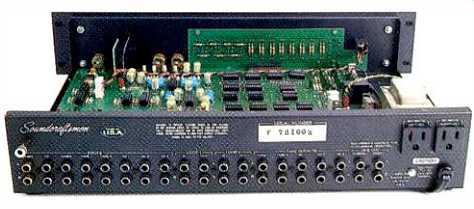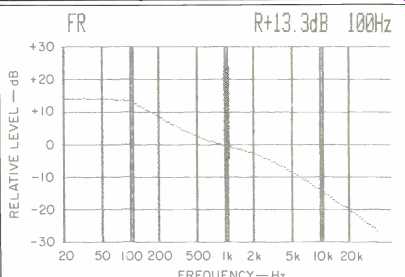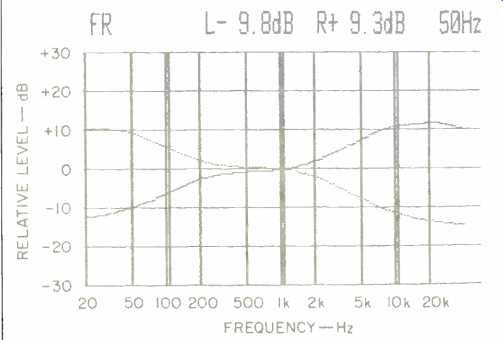
Manufacturer's Specifications:
Frequency Response: 20 Hz to 20 kHz. ±0.1 dB.
Input Sensitivity (For 0.5 V Out put): Phono, 1.75 mV; high level, 120 mV.
S/N (A-Weighted, re: 2 V Output):
Phono, 85 dB; high level, 105 dB.
Maximum Output: 8.5 V.
THD + Noise: High level, less than 0.005%.
SMPTE IM: Less than 0.005%.
Tone-Control Range: Bass,-±10 dB at 60 Hz; treble, ± 10 dB at 10 kHz.
Output Impedance: 180 ohms.
Crosstalk: 90 dB.
Dimensions: 19 in. W x 3 1/2 in. H x. 10 1/2 in. D (48.3 cm x 8.9 cm x 26.7 cm).
Weight: 9 1/2 lbs. (4.3 kg).
Price: $699
Company Address: 2200 South Ritchey, Santa Ana, Cal. 92705.

Something I've always admired about Soundcraftsmen products is their ability to provide a great deal of flexibility and control without sacrificing the simplicity and direct signal paths of true "high-end" components. Soundcraftsmen may have a lower profile in the audio marketplace than do some of the more flamboyant West Coast audio firms, but if you check the U.S. Patent Office, you'll find that this company's engineers have contributed more than a modest number of circuit innovations over the years. A classic example is the so-called "Class-H" circuit, which utilizes a two-level output-stage power supply for improved efficiency in Class-AB and Class-B power amplifiers.
The Pro-Control Four preamplifier is another example of Soundcraftsmen's superb engineering and dedication to user convenience and product flexibility. It serves as a true control center without adding complications for the user.
The preamp employs an independent solid-state switching technique designed by Paul Rolfes, the company's chief engineer. This switching system lets you route any input to the line outputs while independently routing that signal, or any other, to the five tape-recorder outputs (two nominally for audio decks, three nominally for the audio tracks of video recorders). Front-panel LEDs make it easy to keep track of system status; green LEDs show which inputs and processor loops have been selected for listening, and red ones tell you which have been selected for recording.
In addition to the multiple tape recorder loops, two more external signal-processor loops connect such components as equalizers, surround-sound processors, and ambience-recovery devices. These two loops can also be switched to function in either the "Listen" (line output) or the "Record" (tape output) mode. This flexibility allows you to conveniently and quickly apply an externally connected processor to the signal to which you are listening and another to the signal being recorded.
Subsonic filtering is available too, for either the listening or recording mode or for both at once. Conventional bass and treble controls are available in the listening mode only. For those who object to the presence of any signal-processing circuitry in a "pure audiophile-type" preamplifier, all such controls can be eliminated in the listen mode by touching a front-panel button labeled "Direct."
Control Layout
The Pro-Control Four's all-black, rack-mountable front panel has white control designations that I found easy to read even in subdued lighting. The rack-mounting holes come fitted with unobtrusive black plugs that eliminate this preamp's "industrial" look should you choose not to mount it in a "professional" rack.
A stereo phone jack is located above the "Power" button at the left end of the front panel. Nearby are buttons labeled "Listen" and "Record." Successive pushes of the "Listen" button cause the solid-state switching circuitry to connect CD, tuner, phono, or any of the five tape inputs to the signal path leading to line output; doing the same with the "Re cord" button makes connections to the five tape outputs.
Designations for the program sources and the tape inputs/ outputs are given in a horizontal row to the right of "Listen" and "Record"; the green LEDs mentioned earlier are located above the designations, and the red LEDs are below.
Just to the right of the front panel's center are two buttons for introducing the external signal-processing loops, plus a sor loops have been selected for listening, and red ones tell you which have been selected for recording.
In addition to the multiple tape recorder loops, two more external signal-processor loops connect such components as equalizers, surround-sound processors, and ambience-recovery devices. These two loops can also be switched to function in either the "Listen" (line output) or the "Record" (tape output) mode. This flexibility allows you to conveniently and quickly apply an externally connected processor to the signal to which you are listening and another to the signal being recorded.
Subsonic filtering is available too, for either the listening or recording mode or for both at once. Conventional bass and treble controls are available in the listening mode only. For those who object to the presence of any signal-processing circuitry in a "pure audiophile-type" preamplifier, all such controls can be eliminated in the listen mode by touching a front-panel button labeled "Direct."
Control Layout
The Pro-Control Four's all-black, rack-mountable front panel has white control designations that I found easy to read even in subdued lighting. The rack-mounting holes come fitted with unobtrusive black plugs that eliminate this preamp's "industrial" look should you choose not to mount it in a "professional" rack.
A stereo phone jack is located above the "Power" button at the left end of the front panel. Nearby are buttons labeled "Listen" and "Record." Successive pushes of the "Listen" button cause the solid-state switching circuitry to connect CD, tuner, phono, or any of the five tape inputs to the signal path leading to line output; doing the same with the "Re cord" button makes connections to the five tape outputs.
Designations for the program sources and the tape inputs/ outputs are given in a horizontal row to the right of "Listen" and "Record"; the green LEDs mentioned earlier are located above the designations, and the red LEDs are below.
Just to the right of the front panel's center are two buttons for introducing the external signal-processing loops, plus a subsonic filter button and the "Direct" button which allows bypassing of all control circuitry. Pushing either of the signal-processing buttons once will introduce an external processor into the "Listen" (line output) path, and pushing it again will introduce that processor into the "Record" path instead; however, the same processor cannot be applied to both paths simultaneously. The "Subsonic" button inserts a subsonic filter into either or both paths.
Small rotary knobs farther to the right adjust bass and treble. Completing the layout, at the far right of the front panel, are a large master volume-control knob, with a green LED that acts as a calibration pointer, and a small rotary channel-balance control.
The rear panel has 19 pairs of input and output jacks arranged neatly across nearly its entire width. Here, too, labeling is legible; even more important, it's easy to under stand. All inputs except those for external processors are grouped at the left, with a ground terminal near the gold plated phono inputs. The "In" and "Out" jacks for the two external loops are at mid-panel, and the five sets of tape output jacks are farther to the right. After these come two sets of line output jacks-normal and inverted. Some power amplifiers invert polarity from input to output; the availability of the inverted-polarity output jacks on this preamp makes it possible to re-invert the signal, if such an amp is used, so that correct polarity can be maintained from the preamp input to the speaker terminals. However, according to Soundcraftsmen, the main purpose of the inverted output is to allow the user to bridge two standard stereo power amps for greater power capability without using external adaptors, which could degrade the signal.
A pair of a.c. receptacles, one switched and the other unswitched, is at the extreme right edge of the rear panel.
Although such receptacles are quite commonly found on the rear panels of audio equipment, those on the Pro-Control Four have enough power-handling capacity to be of practical use. The switched receptacle can handle up to 600 watts of power-more than enough to allow connection of most power amplifiers-and the unswitched receptacle can handle up to 550 watts. These receptacles are of the grounded type to accept the three-prong power cords now commonly supplied with many audio components. I'm sure many of you, like me, have sometimes wanted to connect a component to the power line via a convenience receptacle on another component only to discover that the receptacle was a two-slot type, while the line cord had a three-prong plug. Many people either cut off the third prong of the plug or install a "cheater" adaptor, without bothering to connect the green ground wire to a suitable ground point. Either course of action defeats the safety aspect of the three-prong plug. There's no such concern with the a.c. receptacles on this Soundcraftsmen preamp-a small point, perhaps, but indicative of the good thinking that went into the Pro-Control Four.
Measurements

Fig. 1--RIAA playback characteristics.

Fig. 2-THD + N vs. input level.

Fig. 3-Tone-control characteristics.
Frequency response for all of the high-level inputs was so flat throughout the audio range that any response curve I might plot would simply be a straight line, no matter how much I expanded the vertical scale. There wasn't so much as 0.1 dB of variation in amplitude from 20 Hz to 20 kHz, The -1.0 dB points were reached at 5 Hz and 165 kHz. As for RIAA equalization, it was accurate to within 0.2 dB at 100 Hz and within 0.4 dB at 10 kHz. The preamp's RIAA playback curve is shown in Fig. 1; the actual bass boost at 100 Hz was 13.3 dB, as shown, and the actual treble cut at 10 kHz was 14.1 dB.
Harmonic distortion plus noise via the high-level inputs, for 0.5 V input and with the volume control set at maximum, measured 0.0045% at 1 kHz, 0.005% at 20 Hz, and 0.0047% at 20 kHz. I should point out, however, that for other input levels, THD + N increased slightly, as depicted in the curves of Fig. 2.
Distortion decreased when the "Direct" or bypass mode was used. For example, with 0.5 V applied and the volume control set at maximum, high-level THD + N was only 0.0028% at 1 kHz, 0.003% at 20 kHz, and 0.0035% at 20 Hz.
When switching from the normal to the "Direct" mode, I noted a very slight change in gain--no more than 0.1 dB-for any setting of the master volume control.
SMPTE-IM distortion measured 0.006% with 1 V input and the volume control adjusted for 2 V output. With 0.5 V in, IM increased slightly to 0.009%, and with 2 V input, IM in creased a bit further, to a still insignificant 0.011%.
Input sensitivity via the high-level inputs was 125 mV for 0.5 V output. I was somewhat surprised to find that although Soundcraftsmen quotes input sensitivity in accordance with the IHF/EIA Standard (which calls for a reference output of 0.5 V), they do not follow the same practice when specifying signal-to-noise ratio. Here, the IHF/EIA Standard calls for a 0.5-V signal for high-level inputs and a 5-mV signal for moving-magnet phono inputs. In each case, the volume control is then adjusted to produce an output of 0.5 V.
Soundcraftsmen chose to reference an output level of 2 V, thereby coming up with a somewhat higher S/N figure than I did. Even so, my signal-to-noise reading for the high-level inputs was an outstanding 95 dB, A-weighted. I can't re member any other audio amplifier, preamplifier, or receiver that yielded such a high value for S/N. Since 0.5 V is approximately 12 dB lower than 2.0 V, I would have come up with a figure of 107 dB--actually 2 dB better than claimed--if I had conducted the test as Soundcraftsmen's engineers did.
THD + N via the phono inputs measured 0.015% for a 1-kHz, 5-mV input with 1.5 V appearing at the output. At 100 Hz, THD + N rose to 0.02%, and at 10 kHz it decreased to 0.01%. Phono sensitivity for 0.5 V output (the standard EIA reference level) measured 1.8 mV. Phono overload was the only even mildly disappointing measurement. I usually expect phono overload of such a carefully designed preamplifier stage to be at least 100 mV for a 1-kHz signal, but for this preamp it measured 90 mV.
Signal-to-noise ratio in phono, referred to 5 mV input and 0.5 V output, was 84 dB. When I used the Soundcraftsmen's volume control to raise the reference level to 2 V output, the S/N ratio increased somewhat, to 87 dB. At this level, the relationship between S/N and output is no longer a linear one, since the limiting noise factor is produced by the preamplifier stages and is therefore nearly independent of volume-control settings.
Maximum output level before clipping was 9.3 V, and crosstalk between different sets of inputs was 92 dB. The bass control yielded 9.3 dB of boost and 9.8 dB of cut at 50 Hz, and the treble control yielded 10.9 dB of boost and 11.2 dB of cut at 10 kHz. The tone-control curves are shown in Fig. 3.
Use and Listening Tests
Although all of the measurements I made of the Pro-Control Four were certainly beyond criticism, my full appreciation for this well-designed component came only when I began to use it and to listen to different program sources through it. With the tone controls set to their flat positions (easily accomplished, thanks to well-defined detents at the controls' midpoints of rotation), I could not honestly detect any difference in sound quality between the normal mode and the "Direct" mode. Perhaps listeners more critical than I will be able to hear some improvement when switching to the "Direct" mode; if they do, fine. For my ears, both settings yielded absolutely clean, uncolored sound that was no different from what I heard when the same high-level program sources were connected directly to a power amplifier. (This is a good test for any preamplifier, whose main purpose should be control rather than signal modification.) My chief delight with the Pro-Control Four was its solid state switching logic. What a joy to be able to switch a program source to a tape-out jack without hearing any switching noise or click in the program I was listening to at the time. Operation of this preamp/control unit is so neatly arranged that I was even inspired to pull out some of my old, long-abandoned LPs and play them on my almost totally abandoned turntable. You will probably be a bit surprised at the absence of moving-coil cartridge inputs on this preamplifier, but I reason it this way: Most audiophiles who are astute enough to appreciate a control unit like this one, and who also want to use an MC cartridge, are more than likely going to want a separate pre-preamp, or perhaps even a step-up transformer, to go with it. That being the case, Soundcraftsmen was wise in not penalizing those of us who prefer moving-magnet cartridges by adding a feature that would have raised the price of this preamp. As I think about it, Soundcraftsmen has exhibited audio wisdom in all aspects of the Pro-Control Four's design. To Paul Rolfes and his crew, my sincere congratulations!
--Leonard Feldman
(Audio magazine, Feb. 1988)
Also see:
Soundcraftsmen SP 4001 Preamplifier-Equalizer (Nov. 1980)
Soundcraftsmen PCR800 Power Amplifier (Aug. 1984)
Soundcraftsmen Pro-Power Ten Amplifier (Sept. 1989)
Spectro-Acoustics Model 217 Preamplifier (Feb. 1978)
= = = =